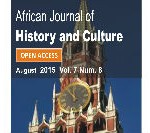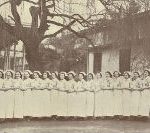December 2017
Frances Wilson / The Guardian
Much of London is invisible to its inhabitants. We are largely unaware, for example, of the 250 miles of railway track running underground and the hundreds of other lives being lived in the buildings that surround our own. Despite having lived on the same road in Kentish Town for 20 years, I have never seen the inside of a neighbour’s house.

Tuberculosis patients from St Thomas’ hospital rest in their beds by the River Thames in May 1936, opposite the houses of parliament. Photograph: Fox Photos/Getty Images. Published in The Guardian 26 Nov 2018
I am continually reminded of those things I can’t see: a plaque round the corner tells me that the River Fleet flows beneath me, and there are always photographs tied to lamp posts telling me to look out for pets who have disappeared, as my cat did, into the maelstrom of back yards. People also disappear in London, which is one reason why they come here. I’m only aware of how much I want to vanish into the sea of faces when I leave the city and find myself uncomfortably visible again.
But the most strikingly invisible part of London is the air we breathe. Since the Clean Air Act 1956 we no longer have the peasoupers like the one described by Charles Dickens in Bleak House where there is fog everywhere, “making a soft black drizzle with flakes of soot as big as full-grown snowflakes”. But just because the air is now clear doesn’t mean it is clean.
London air is thick with bacteria, one strain of which – the tubercle bacillus – is a major cause of tuberculosis (TB). The development, in the 1940s and 50s, of the drugs streptomycin and isoniazid led many people – myself included – to assume that TB had been eradicated. But like so much else in London, it had simply gone underground. Of more than 5,000 TB patients diagnosed in England every year, nearly 40% are Londoners. London is the TB capital of Europe. Read the full story in The Guardian!
Read about tuberculosis in Manguinhos:
Tuberculosis y arquitectura – Este artículo constata la influencia que ha ejercido la tuberculosis en la formalización de la arquitectura del turismo de masas.
La tuberculosis en la literatura argentina – Las visiones de tres autores sobre la tuberculosis en la primera mitad del siglo XX: Evaristo Carriego, Ulises Pettit de Murat y Roberto Arlt.
Tuberculosis infantil en Argentina, 1893-1920 – El trabajo analiza la vida cotidiana de los ‘niños tuberculosos’ que fueron internados en el Hospital Marítimo, Mar del Plata.
El programa de control de la tuberculosis en Chile, 1973-2013 – El libro ofrece un panorama de las acciones de Chile para el control de la tuberculosis en el siglo XX.
Tuberculosis y mundo laboral en Colombia, 1916-1946 – El artículo examina la tuberculosis como enfermedad profesional y los usos de estadísticas en discursos oficiales.
Tuberculosis en Argentina – E artículo examina la curva de mortalidad por tuberculosis en Argentina a lo largo del siglo XX considerando las diferentes regiones y momentos históricos.
Race and the Rockefeller Foundation – From 1927 to 1942, the Rockefeller Foundation ran a tuberculosis commission in Jamaica. This paper explores the role that race played in it.
Álvarez, Adriana. La experiencia de ser un ‘niño débil y enfermo’ lejos de su hogar: el caso del Asilo Marítimo, Mar del Plata (1893-1920). Hist. cienc. saude-Manguinhos, Mar 2010, vol.17, no.1, p.13-31. ISSN 0104-5970
Vianna, Paula V. Carnevale, Zanetti, Valéria and Papali, Maria Aparecida. Geografia, saúde e desenvolvimento urbano no interior paulista na passagem para o século XX: Domingos Jaguaribe e a construção da Estância Climática de Campos do Jordão. Hist. cienc. saude-Manguinhos, Dez 2014, vol.21, no.4, p.1341-1360. ISSN 0104-5970
Herrero, Maria Belen and Carbonetti, Adrian. La mortalidad por tuberculosis en Argentina a lo largo del siglo XX. Hist. cienc. saude-Manguinhos, Jun 2013, vol.20, no.2, p.521-536. ISSN 0104-5970
Ortega Martos, Antonio Miguel. ¿Colonialismo biomédico o autonomía de lo local? Sanadores tradicionales contra la tuberculosis. Hist. cienc. saude-Manguinhos, Dic 2010, vol.17, no.4, p.909-924. ISSN 0104-5970
Armus, Diego. Milonguitas” en Buenos Aires (1910-1940): tango, ascenso social y tuberculosis. Hist. cienc. saude-Manguinhos, 2002, vol.9, p.187-207. ISSN 0104-5970







